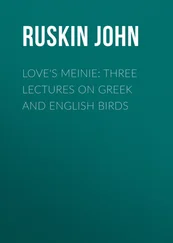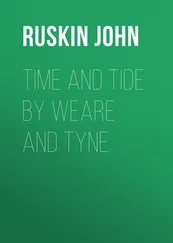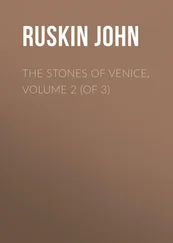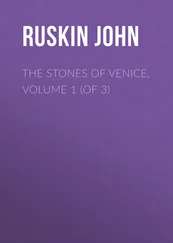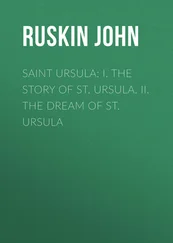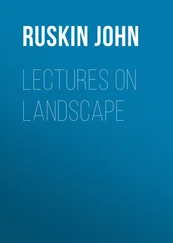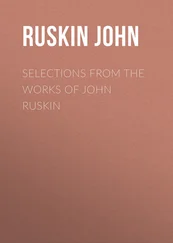John Ruskin - Proserpina, Volume 2
Здесь есть возможность читать онлайн «John Ruskin - Proserpina, Volume 2» — ознакомительный отрывок электронной книги совершенно бесплатно, а после прочтения отрывка купить полную версию. В некоторых случаях можно слушать аудио, скачать через торрент в формате fb2 и присутствует краткое содержание. Жанр: foreign_antique, Биология, literature_19, foreign_edu, на английском языке. Описание произведения, (предисловие) а так же отзывы посетителей доступны на портале библиотеки ЛибКат.
- Название:Proserpina, Volume 2
- Автор:
- Жанр:
- Год:неизвестен
- ISBN:нет данных
- Рейтинг книги:5 / 5. Голосов: 1
-
Избранное:Добавить в избранное
- Отзывы:
-
Ваша оценка:
- 100
- 1
- 2
- 3
- 4
- 5
Proserpina, Volume 2: краткое содержание, описание и аннотация
Предлагаем к чтению аннотацию, описание, краткое содержание или предисловие (зависит от того, что написал сам автор книги «Proserpina, Volume 2»). Если вы не нашли необходимую информацию о книге — напишите в комментариях, мы постараемся отыскать её.
Proserpina, Volume 2 — читать онлайн ознакомительный отрывок
Ниже представлен текст книги, разбитый по страницам. Система сохранения места последней прочитанной страницы, позволяет с удобством читать онлайн бесплатно книгу «Proserpina, Volume 2», без необходимости каждый раз заново искать на чём Вы остановились. Поставьте закладку, и сможете в любой момент перейти на страницу, на которой закончили чтение.
Интервал:
Закладка:
"Qu'est ce que c'est que la Pensée? Cette jolie plante appartient aussi ou genre Viola, mais à un section de ce genre. En effet, dans les Pensées, les pétales supérieurs et lateraux sont dirigés en haut, l'inférieur seul est dirigé en bas: et de plus, le stigmate est urcéole, globuleux."
And farther, this general description of the whole violet tribe, which I translate, that we may have its full value:—
"The violet is a plant without a stem (tige),—(see vol. i., p. 154,)—whose height does not surpass one or two decimetres. Its leaves, radical, or carried on stolons, (vol. i., p. 158,) are sharp, or oval, crenulate, or heart-shape. Its stipules are oval-acuminate, or lanceolate. Its flowers, of sweet scent, of a dark violet or a reddish blue, are carried each on a slender peduncle, which bends down at the summit. Such is, for the botanist, the Violet, of which the poets would give assuredly another description."
17. Perhaps; or even the painters! or even an ordinary unbotanical human creature! I must set about my business, at any rate, in my own way, now, as I best can, looking first at things themselves, and then putting this and that together, out of these botanical persons, which they can't put together out of themselves. And first, I go down into my kitchen garden, where the path to the lake has a border of pansies on both sides all the way down, with clusters of narcissus behind them. And pulling up a handful of pansies by the roots, I find them "without stems," indeed, if a stem means a wooden thing; but I should say, for a low-growing flower, quiet lankily and disagreeably stalky! And, thinking over what I remember about wild pansies, I find an impression on my mind of their being rather more stalky, always, than is quite graceful; and, for all their fine flowers, having rather a weedy and littery look, and getting into places where they have no business. See, again, vol. i., chap. vi., § 5.
18. And now, going up into my flower and fruit garden, I find (June 2nd, 1881, half-past six, morning.) among the wild saxifrages, which are allowed to grow wherever they like, and the rock strawberries, and Francescas, which are coaxed to grow wherever there is a bit of rough ground for them, a bunch or two of pale pansies, or violets, I don't know well which, by the flower; but the entire company of them has a ragged, jagged, unpurpose-like look; extremely,—I should say,—demoralizing to all the little plants in their neighbourhood: and on gathering a flower, I find it is a nasty big thing, all of a feeble blue, and with two things like horns, or thorns, sticking out where its ears would be, if the pansy's frequently monkey face were underneath them. Which I find to be two of the leaves of its calyx 'out of place,' and, at all events, for their part, therefore, weedy, and insolent.
19. I perceive, farther, that this disorderly flower is lifted on a lanky, awkward, springless, and yet stiff flower-stalk; which is not round, as a flower-stalk ought to be, (vol. i., p. 155,) but obstinately square, and fluted, with projecting edges, like a pillar run thin out of an iron-foundry for a cheap railway station. I perceive also that it has set on it, just before turning down to carry the flower, two little jaggy and indefinable leaves,—their colour a little more violet than the blossom.
These, and such undeveloping leaves, wherever they occur, are called 'bracts' by botanists, a good word, from the Latin 'bractea,' meaning a piece of metal plate, so thin as to crackle. They seem always a little stiff, like bad parchment,—born to come to nothing—a sort of infinitesimal fairy-lawyer's deed. They ought to have been in my index at p. 255, under the head of leaves, and are frequent in flower structure,—never, as far as one can see, of the smallest use. They are constant, however, in the flower-stalk of the whole violet tribe.
20. I perceive, farther, that this lanky flower-stalk, bending a little in a crabbed, broken way, like an obstinate person tired, pushes itself up out of a still more stubborn, nondescript, hollow angular, dogseared gas-pipe of a stalk, with a section something like this,
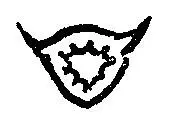
but no bigger than with a quantity of ill-made and ill-hemmed leaves on it, of no describable leaf-cloth or texture,—not cressic, (though the thing does altogether look a good deal like a quite uneatable old watercress); not salvian, for there's no look of warmth or comfort in them; not cauline, for there's no juice in them; not dryad, for there's no strength in them, nor apparent use: they seem only there, as far as I can make out, to spoil the flower, and take the good out of my garden bed. Nobody in the world could draw them, they are so mixed up together, and crumpled and hacked about, as if some ill-natured child had snipped them with blunt scissors, and an ill-natured cow chewed them a little afterwards and left them, proved for too tough or too bitter.
21. Having now sufficiently observed, it seems to me, this incongruous plant, I proceed to ask myself, over it, M. Figuier's question, 'Qu'est-ce c'est qu'un Pensée?' Is this a violet—or a pansy—or a bad imitation of both?
Whereupon I try if it has any scent: and to my much surprise, find it has a full and soft one—which I suppose is what my gardener keeps it for! According to Dr. Lindley, then, it must be a violet! But according to M. Figuier,—let me see, do its middle petals bend up, or down?
I think I'll go and ask the gardener what he calls it.
22. My gardener, on appeal to him, tells me it is the 'Viola Cornuta,' but that he does not know himself if it is violet or pansy. I take my Loudon again, and find there were fifty-three species of violets, known in his days, of which, as it chances, Cornuta is exactly the last.
'Horned violet': I said the green things were like horns!—but what is one to say of, or to do to, scientific people, who first call the spur of the violet's petal, horn, and then its calyx points, horns, and never define a 'horn' all the while!
Viola Cornuta, however, let it be; for the name does mean some thing, and is not false Latin. But whether violet or pansy, I must look farther to find out.
23. I take the Flora Danica, in which I at least am sure of finding whatever is done at all, done as well as honesty and care can; and look what species of violets it gives.
Nine, in the first ten volumes of it; four in their modern sequel (that I know of,—I have had no time to examine the last issues). Namely, in alphabetical order, with their present Latin, or tentative Latin, names; and in plain English, the senses intended by the hapless scientific people, in such their tentative Latin:—
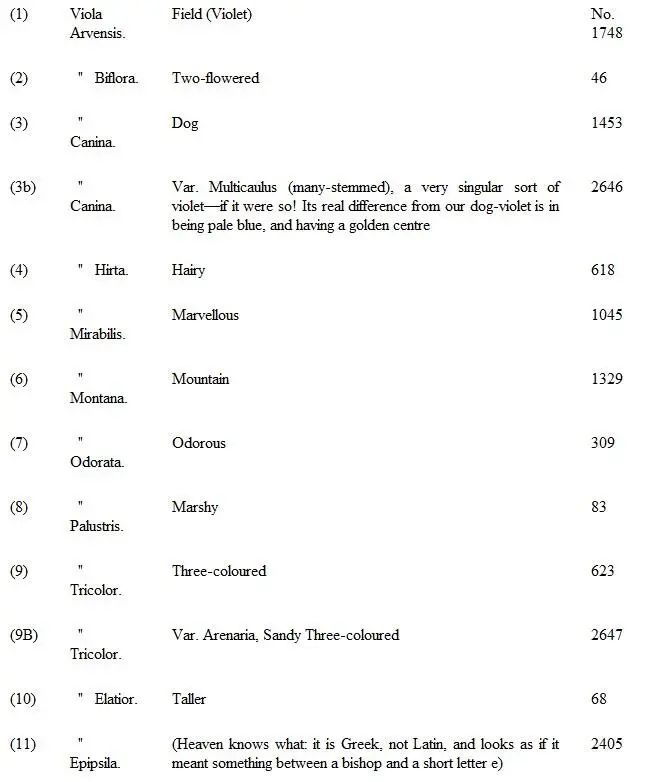
I next run down this list, noting what names we can keep, and what we can't; and what aren't worth keeping, if we could: passing over the varieties, however, for the present, wholly.
(1) Arvensis. Field-violet. Good.
(2) Biflora. A good epithet, but in false Latin. It is to be our Viola aurea, golden pansy.
(3) Canina. Dog. Not pretty, but intelligible, and by common use now classical. Must stay.
(4) Hirta. Late Latin slang for hirsuta, and always used of nasty places or nasty people; it shall not stay. The species shall be our Viola Seclusa,—Monk's violet—meaning the kind of monk who leads a rough life like Elijah's, or the Baptist's, or Esau's—in another kind. This violet is one of the loveliest that grows.
(5) Mirabilis. Stays so; marvellous enough, truly: not more so than all violets; but I am very glad to hear of scientific people capable of admiring anything.
Читать дальшеИнтервал:
Закладка:
Похожие книги на «Proserpina, Volume 2»
Представляем Вашему вниманию похожие книги на «Proserpina, Volume 2» списком для выбора. Мы отобрали схожую по названию и смыслу литературу в надежде предоставить читателям больше вариантов отыскать новые, интересные, ещё непрочитанные произведения.
Обсуждение, отзывы о книге «Proserpina, Volume 2» и просто собственные мнения читателей. Оставьте ваши комментарии, напишите, что Вы думаете о произведении, его смысле или главных героях. Укажите что конкретно понравилось, а что нет, и почему Вы так считаете.




